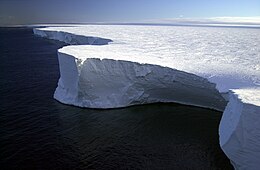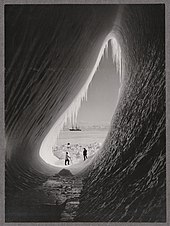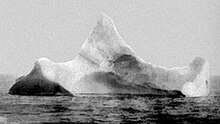برف جون ڇپون

برف جي ڇپ (Iceberg) 15 ميٽر کان وڌيڪ ڊگھي تازي پاڻيءَ جي برف جو هڪ ٽڪرو آهي[1] جيڪو ڪنهن گليشيئر يا برف جي شيلف کي ٽوڙي ڇڏيو آهي ۽ کليل پاڻيءَ ۾ آزاديءَ سان تري رهيو آهي.[2][3] ترندڙ برفاني طور تي نڪتل برف جي ننڍڙن ٽڪرن کي ”گرولر“ يا ”برگي بِٽ“ چئبو آهي.[4][5] برفاني ٽڪر جو گهڻو حصو پاڻيءَ جي مٿاڇري کان هيٺ هوندو آهي، جنهن جي نتيجي ۾ ”آئس برگ جو ٽپ“ ظاهر ڪيو ويو آهي ته جيئن ڪنهن وڏي اڻ ڏٺي مسئلي جي هڪ ننڍڙي حصي کي واضح ڪري سگهجي. برف جون ڇپون هڪ سنگين سامونڊي خطرو سمجهيو ويندو آهي.
برف جون ڇپون سائيز ۽ شڪل ۾ ڪافي مختلف آهن. گرين لينڊ ۾ گليشيئرز مان نڪرندڙ برفاني ٽڪرا اڪثر بي ترتيب شڪل ۾ هوندا آهن جڏهن ته انٽارڪٽڪ جي برفاني پناهه گاهه اڪثر ڪري وڏا ٽئبلر (ٽيبل ٽاپ) آئس برگ پيدا ڪندا آهن. تازي تاريخ ۾ سڀ کان وڏو برفاني ٿلهو، جنهن جو نالو B-15 آهي، سال 2000ع ۾ تقريباً 300 ماپ ڪان 40 ڪلوميٽر (186 ماپ کان 25 ميل) تي ماپيو ويو. [6] ریڪارڊ تي سڀ کان وڏو آئس برگ هڪ انٽارڪٽڪ ٽيبلولر آئس برگ هو، جنهن جي ماپ 335 کان 97 ڪلوميٽر آهي (240 کان 60 ميل) 240 ڪلوميٽر (150 ميل) ڏکڻ پئسفڪ سمنڊ ۾ اسڪاٽ ٻيٽ جي اولهه ۾ يو ايس ايس گليشيئر طرفان 12 نومبر 1956ع تي ڏٺو ويو. هي برفاني برفاني ٽڪرو بيلجيم کان به وڏو هو.[7]
برف جون ڇپون دنيا جي اتر قطب يا ڏکڻ قطب ڏي جيترو ويجهو وڃبو، اوترو گهڻي ٿڌ ملندي. آخر اهڙو هنڌ شروع ٿي ويندو، جتان کان وڌيڪ اڳيان سخت سيءَ ڪري سڄو سمنڊ برف وانگر ڄميل ملندو. اونهاري جي موسم ۾ سمنڊ جا ڪجهه برفاني حصا باقي ڄميل برف کان ڇڄي ڌار ٿي، پاڻيءَ ۾ ترڻ لڳندا آهن. اتر ناروي ۽ ڪئناڊا پاسي جهاز هلائيندي برف جون اهي ڇپون (آئيس برگ) نظر اينديون آهن. اهي آئيس برگ ڪافي وڏا ٿين ٿا. ڪي ڪي ته جهاز کان به ٻيڻا ٽيڻا وڏا ٿين ٿا. پر تپرس جي اها ڳالهه آهي ته سمنڊ جي مٿان نظر ايندڙ هي آئيس برگ سڄي آئيس برگ جو فقط هڪ حصو هوندا آهن. جيئن جهاز جيترو نظر اچي ٿو، اوترو سمند اندر به ٿئي ٿو. اهڙيءَ طرح نظر ايندڙ هيءَ ”برف جي ڇپ“ اصل ۾ ”آئيس برگ“ جي فقط ٽپ ھوندي آھي، باقي ان جو اٺوڻ يا نائوڻ جيترو حصو سمنڊ اندر ھوندو آھي. ان ڪري هنن آفت جيڏن آئيس برگ سان پاڻيءَ جو جهاز ٽڪرائجي تباهه ٿي سگهي ٿو.[8][9]
نالو
[سنواريو]لفظ آئسبرگ ڊچ لفظ ائجسبرگ (ijsberg) مان هڪ جزوي قرض ترجمو آهي، لفظي معني آهي برف جو جبل. اهو ڊینش اسبجرگ (isbjerg)، جرمن ايسبرگ (Isberg)، لو سيڪسونی آئيسبرگ ۽ سويڊش اسبرگ کي سڃاڻي ٿو.
جائزو
[سنواريو]عام طور تي آئس برگ جي مقدار جو ڏھون حصو پاڻيءَ کان مٿي هوندو آهي، جيڪو آرشيميڊس جي بوائينسيءَ جي اصول جي پٺيان آهي؛ خالص برف جي کثافت اٽڪل 920 ڪلوگرام في مڪعب ميٽر (57 پائونڊ في مڪعب فوٽ) آهي، ۽ سمنڊ جي پاڻي جي اٽڪل 1.025 ڪلوگرام في مڪعب ميٽر (64 پائونڊ في مڪعب فوٽ) آهي. مٿاڇري کان مٿي واري حصي کي ڏسي پاڻيءَ جي هيٺان حصي جو سمورو اندازو لڳائڻ مشڪل ٿي سگھي ٿو.

| Size class | Height (m) | Length (m) |
|---|---|---|
| Growler | <1 | <5 |
| Bergy bit | 1–5 | 5–15 |
| Small | 5–15 | 15–60 |
| Medium | 15–45 | 60–122 |
| Large | 45–75 | 122–213 |
| Very large | >75 | >213 |
The largest icebergs recorded have been calved, or broken off, from the Ross Ice Shelf of Antarctica. Icebergs may reach a height of more than 100 ميٽر (300 ft) above the sea surface and have mass ranging from about 100,000 tonnes up to more than 10 million tonnes. Icebergs or pieces of floating ice smaller than 5 meters above the sea surface are classified as "bergy bits"; smaller than 1 meter—"growlers".[11] The largest known iceberg in the North Atlantic was 168 ميٽر (551 ft) above sea level, reported by the USCG icebreaker Eastwind in 1958, making it the height of a 55-story building. These icebergs originate from the glaciers of western Greenland and may have interior temperatures of −15 تائين −20 °C (5 تائين −4 °F).[12]

Drift
[سنواريو]A given iceberg's trajectory through the ocean can be modelled by integrating the equation
where m is the iceberg mass, v the drift velocity, and the variables f, k, and F correspond to the Coriolis force, the vertical unit vector, and a given force. The subscripts a, w, r, s, and p correspond to the air drag, water drag, wave radiation force, sea ice drag, and the horizontal pressure gradient force.[13][14]
Icebergs deteriorate through melting and fracturing, which changes the mass m, as well as the surface area, volume, and stability of the iceberg.[14][15] Iceberg deterioration and drift, therefore, are interconnected iceberg thermodynamics, and fracturing must be considered when modelling iceberg drift.[14]
Winds and currents may move icebergs close to coastlines, where they can become frozen into pack ice (one form of sea ice), or drift into shallow waters, where they can come into contact with the seabed, a phenomenon called seabed gouging.
Mass loss
[سنواريو]Icebergs lose mass due to melting, and calving. Melting can be due to solar radiation, or heat and salt transport from the ocean. Iceberg calving is generally enhanced by waves impacting the iceberg.
Melting tends to be driven by the ocean, rather than solar radiation. Ocean driven melting is often modelled as
where is the melt rate in m/day, is the relative velocity between the iceberg and the ocean, is the temperature difference between the ocean and the iceberg, and is the length of the iceberg. is a constant based on properties of the iceberg and the ocean and is approximately in the polar ocean.[16]
The influence of the shape of an iceberg[17] and of the Coriolis force[18] on iceberg melting rates has been demonstrated in laboratory experiments.
Wave erosion is more poorly constrained but can be estimated by
where is the wave erosion rate in m/day, , describes the sea state, is the sea surface temperature, and is the sea ice concentration.[19]
Bubbles
[سنواريو]Air trapped in snow forms bubbles as the snow is compressed to form firn and then glacial ice.[20] Icebergs can contain up to 10% air bubbles by volume.[20]سانچو:Not in source These bubbles are released during melting, producing a fizzing sound that some may call "Bergie Seltzer". This sound results when the water-ice interface reaches compressed air bubbles trapped in the ice. As each bubble bursts it makes a "popping" sound[12] and the acoustic properties of these bubbles can be used to study iceberg melt.[21]
Stability
[سنواريو]An iceberg may flip, or capsize, as it melts and breaks apart, changing the center of gravity. Capsizing can occur shortly after calving when the iceberg is young and establishing balance.[22] Icebergs are unpredictable and can capsize anytime and without warning. Large icebergs that break off from a glacier front and flip onto the glacier face can push the entire glacier backwards momentarily, producing 'glacial earthquakes' that generate as much energy as an atomic bomb.[23][24]
Color
[سنواريو]Icebergs are generally white because they are covered in snow, but can be green, blue, yellow, black, striped, or even rainbow-colored.[25] Seawater, algae and lack of air bubbles in the ice can create diverse colors. Sediment can create the dirty black coloration present in some icebergs.[26]
Shape
[سنواريو]

In addition to size classification (Table 1), icebergs can be classified on the basis of their shapes. The two basic types of iceberg forms are tabular and non-tabular. Tabular icebergs have steep sides and a flat top, much like a plateau, with a length-to-height ratio of more than 5:1.[27]
This type of iceberg, also known as an ice island,[28] can be quite large, as in the case of Pobeda Ice Island. Antarctic icebergs formed by breaking off from an ice shelf, such as the Ross Ice Shelf or Filchner–Ronne Ice Shelf, are typically tabular. The largest icebergs in the world are formed this way.
Non-tabular icebergs have different shapes and include:[29]
- Dome: An iceberg with a rounded top.
- Pinnacle: An iceberg with one or more spires.
- Wedge: An iceberg with a steep edge on one side and a slope on the opposite side.
- Dry-dock: An iceberg that has eroded to form a slot or channel.
- Blocky: An iceberg with steep, vertical sides and a flat top. It differs from tabular icebergs in that its aspect ratio, the ratio between its width and height, is small, more like that of a block than a flat sheet.
نگراني ۽ ڪنٽرول
[سنواريو]تاريخ
[سنواريو]
سال 1914ع کان اڳ، برف جي ڇپن جي ذريعي ٻيڙين جي موتمار ٻڏڻ جي باوجود، ڇپن کان ٻيڙين جي حفاظت لاء برف جي ڇپن کي ٽريڪ ڪرڻ لاء ڪو نظام موجود نه هو. سال 1907ع ۾، ايس ايس ڪرونپرينز ولهيلم، هڪ جرمن لائنر، هڪ برف جي ڇپ سان ٽڪرائي ڇڏيو ۽ هڪ ٿلهي ڪمان جو شڪار ٿيو، پر هوء اڃا تائين پنهنجو سفر مڪمل ڪرڻ جي قابل هئي.
ٻيڙيءَ جي اڏاوت ۾ واٽر ٽائيٽ ڪمپارٽمينٽلائيزيشن جي اچڻ سبب ڊزائنر پنهنجن جهازن کي ”نا ڊبڻ لائق“ قرار ڏيڻ تي مجبور ٿيا. سال 1912ع ۾ ٽائيٽينڪ جي ٻڏڻ دوران، ٽائيٽينڪ کي ٻڏائڻ واری برف جي ڇپ اندازي مطابق 2,224 مسافرن ۽ عملدارن مان 1,500 کان وڌيڪ مارجي ويو، 'نا ڊبڻ' دعوي کي سنجيده نقصان پهچايو. انهي سال جي برفاني موسم جي باقي رهي، گڏيل قومن جي نيوي پاڻي جي گشت ڪئي ۽ برف جي حرڪتن جي نگراني ڪئي. نومبر 1913ع ۾، سمنڊ ۾ زندگيءَ جي حفاظت تي بين الاقوامي ڪانفرنس لنڊن ۾ ٿي، جنهن ۾ برف جي ڇپن جي مشاهدي جو وڌيڪ مستقل نظام ٺهيو. ٽن مهينن اندر حصو وٺندڙ بحري قومن انٽرنيشنل آئس پيٽرول (IIP) ٺاهي ڇڏيو. IIP جو مقصد موسميات ۽ سامونڊي جانچ (Oceanography) تي ڊيٽا، واء، برف جي وهڪري، سامونڊي گرمي، ۽ لوڻ جي سطح کي ماپڻ لاء ڊيٽا گڏ ڪرڻ هو. هنن نيو فائونڊ لينڊ جي گرانڊ بئنڪز جي ويجهو برفاني خطرن جي نگراني ڪئي ۽ سامونڊي برادريءَ کي ان ڀرپاسي ۾ ”سڀني ڄاتل برف جون حدون“ مهيا ڪيون. IIP پنهنجو پهريون رڪارڊ 1921ع ۾ شايع ڪيو، جنهن جي هڪ سال جي ڀيٽ ۾ برفاني حرڪتن جي مقابلي ۾ اجازت ڏني وئي.
ٽيڪنالاجي ترقي
[سنواريو]سامونڊي سائنس ۽ ماحوليات
[سنواريو]تازیون وڏیون برفاني ڇپون
[سنواريو]ثقافت ۾
[سنواريو]رڪارڊ ٿيل تاريخ ۾ سڀ کان نمايان طور تي سڃاتل آئس برگ مان هڪ اهو آهي جنهن "ٽائيٽينڪ" مسافر جهاز کی 15 اپريل 1912ع تي ٻڏي ويو هو. حادثي کان ڪجهه وقت پوءِ تباهي هڪ بين الاقوامي برفاني گشت جي قيام جو سبب بڻيو. ٻنهي اترين ۽ ڏاکڻين اڌ گولن ۾ برفاني ٽڪرن کي اڪثر ڪري منهٽن ٻيٽ جي 59.1 چورس ڪلوميٽر (22.8 اسڪوائر ميل) ايراضيءَ سان ماپ ۾ ڀيٽيو ويو آهي.[30][31][32][33][34]


آرٽسٽن پنهنجي پينٽنگز لاءِ آئس برگ کي موضوع طور استعمال ڪيو آهي. فريڊرڪ ايڊون چرچ جي "دي آئس برگس"، سال1861ع ۾ نيو فائونڊلينڊ ۽ ليبراڊور کان ٻيڙيءَ جي سفر تي مڪمل ڪيل اسڪيچ مان پينٽ ڪيو ويو.[35] ڪاسپر ڊيوڊ فريڊرچ جي پينٽنگ، ”برف جو سمنڊ“، 1823ع کان 1824ع تائين پولر لينڊ اسڪيپ آهي، جنهن ۾ آئس برگ ۽ جهازن جي تباهي اهڙين حالتن جي خطرن کي ظاهر ڪري ٿي.[36] وليم براد فورڊ آرڪٽڪ ساحلن ۾ قائم ڪيل سامونڊي جهازن جون تفصيلي پينٽنگس ٺاهيا ۽ آئس برگن کان متاثر ٿيو.[37] البرٽ بيئرسٽڊٽ 1883ع ۽ 1884ع ۾ اسٽيم شپس تي آرڪٽڪ جي سفرن جو مطالعو ڪيو، جيڪي اسٽوڊيو ۾ ٺهيل وڏي برفاني پٿرن سان آرڪٽڪ جي منظرن جي تصويرن جو بنياد هئا.[38]
پڻ ڏسو
[سنواريو]- علائقي جي لحاظ کان رڪارڊ ٿيل آئس برگ جي فهرست
- آئس اسٽيشن
- برفباری
- سمنڊ جي برف
- پولر برف جي ٽوپي
- پولر آئس پيڪ
- پولينيا
- سمنڊ جي ڪناري تي برف سان گجگوڙ
- شيلف برف

خارجي لنڪس
[سنواريو]- Iceberg Finder Service for east coast of Canada
- Icebergs of The Arctic and Antarctic
 وڪيذريعات تي Iceberg بابت مواد
وڪيذريعات تي Iceberg بابت مواد
حوالا
[سنواريو]- ↑ "Iceberg Formation: International Ice Patrol" (PDF). International Ice Patrol. وقت 2017-05-09 تي اصل (PDF) کان آرڪائيو ٿيل. حاصل ڪيل 2021-08-23. Unknown parameter
|url-status=ignored (مدد) - ↑ "Definitions of the word 'Iceberg'". حاصل ڪيل 2006-12-20.
- ↑ "Common Misconceptions about Icebergs and Glaciers". Ohio State University.
Icebergs float in salt water, but they are formed from freshwater glacial ice.
- ↑ "bergy bit". National Snow and Ice Data Center. حاصل ڪيل 2019-12-01.
- ↑ "Bergy Bits and Growlers". www.athropolis.com. حاصل ڪيل 2019-12-01.
- ↑ Remy, J.-P.; Becquevort, S.; Haskell, T.G.; Tison, J.-L. (December 2008). "Impact of the B-15 iceberg "stranding event" on the physical and biological properties of sea ice in McMurdo Sound, Ross Sea, Antarctica" (en ۾). Antarctic Science 20 (6): 593–604. doi:. ISSN 0954-1020. Bibcode: 2008AntSc..20..593R. https://www.cambridge.org/core/product/identifier/S0954102008001284/type/journal_article.
- ↑ "Antarctica shed a 208-mile-long berg in 1956". The Polar Times 43: 18. 1956. https://www.usatoday.com/weather/resources/coldscience/2005-01-20-1956-antarctic-iceberg_x.htm.
- ↑ موج نه سهي مڪڙي (الطاف شيخ) | سنڌ سلامت ڪتاب گهر, وقت 2017-09-11 تي اصل کان آرڪائيو ٿيل, حاصل ڪيل 2016-11-20
- ↑ ڪتاب: موج نه سهي مڪڙي
- ↑ حوالي جي چڪ: Invalid
<ref>tag; no text was provided for refs named:0 - ↑ "Iceberg Classification Systems".
- ↑ 12.0 12.1 "Facts on Icebergs". Canadian Geographic. وقت 2006-03-31 تي اصل کان آرڪائيو ٿيل. Unknown parameter
|url-status=ignored (مدد) - ↑ Carlson, Daniel F.; Boone, Wieter; Meire, Lorenz; Abermann, Jakob; Rysgaard, Søren (2017-08-28). "Bergy Bit and Melt Water Trajectories in Godthåbsfjord (SW Greenland) Observed by the Expendable Ice Tracker". Frontiers in Marine Science 4: 276. doi:. ISSN 2296-7745.
- ↑ 14.0 14.1 14.2 Bigg, Grant R.; Wadley, Martin R.; Stevens, David P.; Johnson, John A. (October 1997). "Modelling the dynamics and thermodynamics of icebergs" (en ۾). Cold Regions Science and Technology 26 (2): 113–135. doi:. Bibcode: 1997CRST...26..113B. https://linkinghub.elsevier.com/retrieve/pii/S0165232X97000128.
- ↑ Crawford, Anna; Mueller, Derek; Joyal, Gabriel (2018-04-08). "Surveying Drifting Icebergs and Ice Islands: Deterioration Detection and Mass Estimation with Aerial Photogrammetry and Laser Scanning" (en ۾). Remote Sensing 10 (4): 575. doi:. ISSN 2072-4292. Bibcode: 2018RemS...10..575C.
- ↑ Cenedese, Claudia; Straneo, Fiamma (19 January 2023). "Icebergs Melting". Annual Review of Fluid Mechanics 55 (1): 377–402. doi:. Bibcode: 2023AnRFM..55..377C.
- ↑ Hester, Eric W.; McConnochie, Craig D.; Cenedese, Claudia; Couston, Louis-Alexandre; Vasil, Geoffrey (12 February 2021). "Aspect ratio affects iceberg melting". Physical Review Fluids 6 (2): 023802. doi:. Bibcode: 2021PhRvF...6b3802H.
- ↑ Meroni, Agostino N.; McConnochie, Craig D.; Cenedese, Claudia; Sutherland, Bruce; Snow, Kate (10 January 2019). "Nonlinear influence of the Earth's rotation on iceberg melting". Journal of Fluid Mechanics 858: 832–851. doi:. Bibcode: 2019JFM...858..832M.
- ↑ Cenedese, Claudia; Straneo, Fiamma (19 January 2023). "Icebergs Melting". Annual Review of Fluid Mechanics 55 (1): 377–402. doi:. Bibcode: 2023AnRFM..55..377C.
- ↑ 20.0 20.1 Scholander, P. F.; Nutt, D. C. (1960). "Bubble Pressure in Greenland Icebergs" (en ۾). Journal of Glaciology 3 (28): 671–678. doi:. ISSN 0022-1430.
- ↑ Glowacki, Oskar; Deane, Grant B.; Moskalik, Mateusz (2018-05-16). "The Intensity, Directionality, and Statistics of Underwater Noise From Melting Icebergs" (en ۾). Geophysical Research Letters 45 (9): 4105–4113. doi:. ISSN 0094-8276. Bibcode: 2018GeoRL..45.4105G.
- ↑ MacAyeal, Douglas R.; Abbot, Dorian S.; Sergienko, Olga V. (2011). "Iceberg-capsize tsunamigenesis" (en ۾). Annals of Glaciology 52 (58): 51–56. doi:. ISSN 0260-3055. Bibcode: 2011AnGla..52...51M.
- ↑ Stephen Ornes. "Flipping Icebergs". ScienceNews for Students. حاصل ڪيل June 9, 2019.
- ↑ Nell Greenfieldboyce. "Study Reveals What Happens During A 'Glacial Earthquake'". NPR. حاصل ڪيل March 9, 2021.
- ↑ Katherine Wright. "Icebergs Can Be Green, Black, Striped, Even Rainbow". Scientific American. حاصل ڪيل June 9, 2019.
- ↑ Roach, Lettie. "Image of the Week - Super-cool colours of icebergs". EGU Blogs. European Geosciences Union. حاصل ڪيل 6 November 2020.
- ↑ "Sizes and Shapes of Icebergs" (PDF). International Ice Patrol. حاصل ڪيل 2006-12-20.
- ↑ Weeks, W.F. (2010), On Sea Ice, University of Alaska Press, p. 399
- ↑ Holly Gordon. "Iceberg Physiology". Canadian Geographic. وقت 2006-03-31 تي اصل کان آرڪائيو ٿيل. Unknown parameter
|url-status=ignored (مدد) - ↑ Zamira Rahim (September 14, 2020). "A chunk of ice twice the size of Manhattan has broken off Greenland in the last two years". CNN. https://www.cnn.com/2020/09/14/europe/greenland-arctic-ice-shelf-intl/index.html.
- ↑ Maddie Stone. "An Iceberg 30 Times the Size of Manhattan Is About to Break Off Antarctica". Gizmodo. حاصل ڪيل September 3, 2023.
- ↑ Lorraine Chow. "An iceberg 5 times bigger than Manhattan just broke off from Antarctica". Business Insider. وقت October 27, 2019 تي اصل کان آرڪائيو ٿيل. حاصل ڪيل October 27, 2019. Unknown parameter
|url-status=ignored (مدد) - ↑ "An iceberg about 70 times the size of Manhattan broke off from Antarctica, creating the world's largest iceberg".
- ↑ "An iceberg 80 times the size of Manhattan could destroy a fragile South Atlantic ecosystem".
- ↑ "The Icebergs". Dallas Museum of Art. وقت July 19, 2023 تي اصل کان آرڪائيو ٿيل. حاصل ڪيل March 7, 2024. Unknown parameter
|url-status=ignored (مدد) - ↑ "Online Collection - Caspar David Friedrich, The Sea of Ice, 1823/24". Hamburger Kunsthalle (ٻولي ۾ German). وقت September 22, 2022 تي اصل کان آرڪائيو ٿيل. حاصل ڪيل March 7, 2024. Unknown parameter
|url-status=ignored (مدد) - ↑ Overeem, Irina (January 28, 2018). "Full article/ William Bradford/ Sailing Ships and Arctic Seas". Arctic, Antarctic, and Alpine Research 35 (4): 541. doi:. ISSN 1523-0430. https://www.tandfonline.com/doi/full/10.1657/1523-0430%282003%29035%5B0541%3ABR%5D2.0.CO%3B2. Retrieved March 7, 2024.
- ↑ "Albert Bierstadt (1830-1902), Icebergs". Christie's. وقت March 8, 2024 تي اصل کان آرڪائيو ٿيل. حاصل ڪيل March 8, 2024. Unknown parameter
|url-status=ignored (مدد)
- حوالن ۾ چُڪَ وارا صفحا
- غيرمددي پيراميٽر سان حوالا تي مشتمل صفحا
- سي ايس 1 جي German ٻولي جو مآخذ
- مضمون with short description
- Short description is different from Wikidata
- LCCN سان سڃاڻپ ڪندڙ وڪيپيڊيا مضمون
- GND سان سڃاڻپ ڪندڙ وڪيپيڊيا مضمون
- BNF سان سڃاڻپ ڪندڙ وڪيپيڊيا مضمون
- Bodies of ice
- Icebergs
- Ice in transportation
- Oceanographical terminology
- Snow or ice weather phenomena
- سامونڊي
- سامونڊي سائنس









![{\displaystyle M_{\text{e}}=cS_{s}(T_{\text{s}}+2)[1+{\text{cos}}(I_{\text{c}}^{3}\pi )],}](https://wikimedia.org/api/rest_v1/media/math/render/svg/8425a1bb854b3f5f057b0f8efed4d586cb04b847)




